Why We Love Hardwax Oil Finishes
Recently we were asked to come out and have a look at a tired and well worn hardwood floor that had been installed just over 7 years ago. It was one of the early floors that had a hardwax oil finish applied – OSMO Polyx Oil.
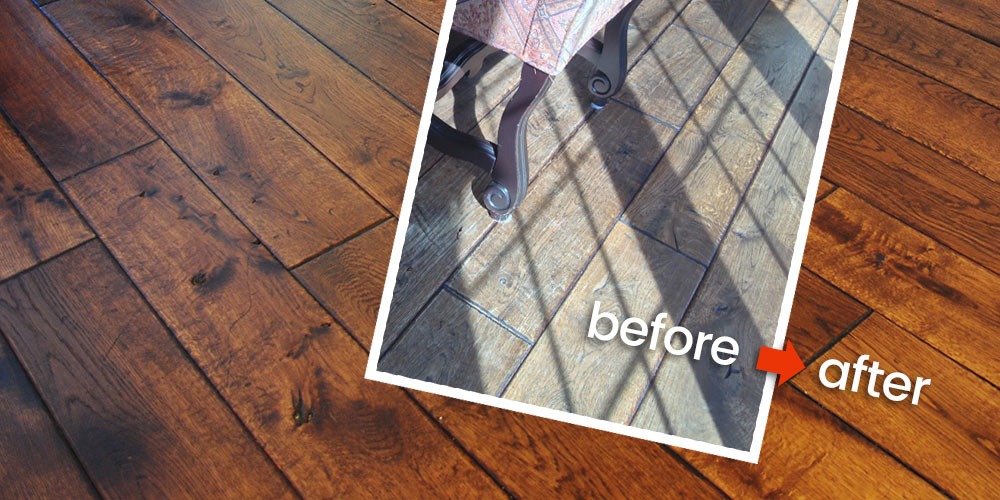
When we showed up to take a look, our first impression wasn’t good. The finish looked like it was in pretty rough shape from a complete lack of maintenance over the years.
Below you can see the condition of the entrance room…
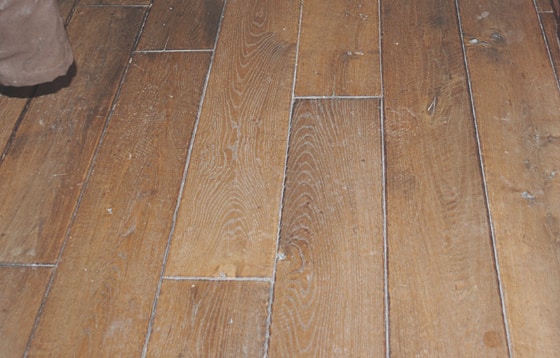
Here’s the dining room. This room had obviously seen a lot of action and was in the worst condition. The finish was very worn down and it was quite dirty from years of traffic…
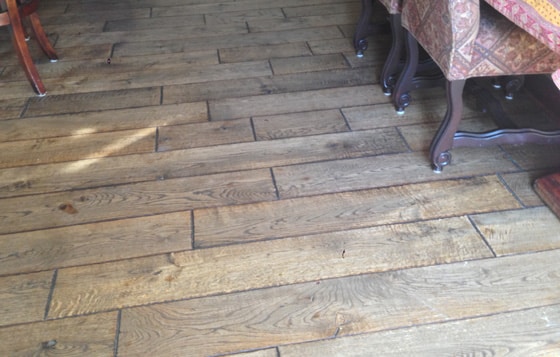
Below you can see what 7 years of wear and no care has done to the kitchen floor…
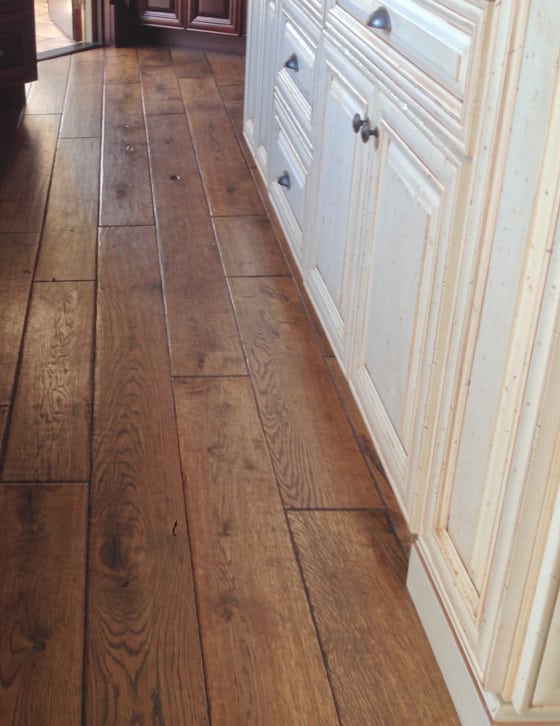
So we set to it and gave the floor a thorough cleaning and then applied another coat of OSMO. It took us under a day to transfer this old tired floor into what it is now.
Take a look at the difference!
After a fresh coat of OSMO Polyx Oil the floors look brand new again…
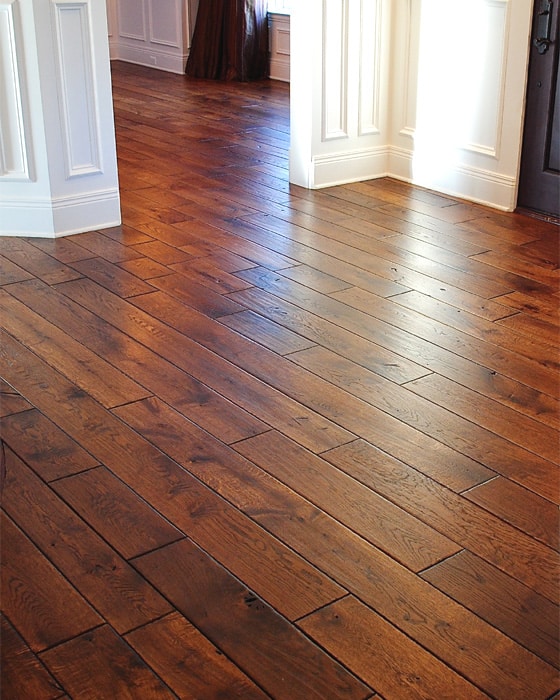
Here’s a close up of the dining room floor (the worst area)…
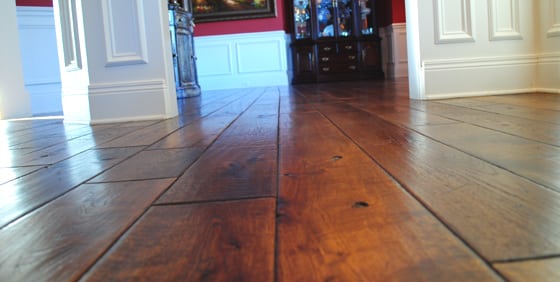
Looks pretty good doesn’t it.
Can you see why we love hardwax oil finishes so much.
There’s no way you could do this in one day and come out with such a great result with any other type of finish. There was no sanding, no dust and no hassles.
Even some of the large and very heavy and delicate furniture was able to stay in place as you can see in the picture below…
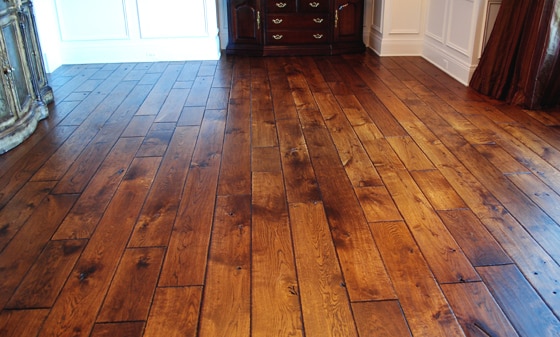
If you ever had any doubt when we said that these hardwax oil finishes can be touched up quickly and easily without sanding back to bare wood and moving the bigger furniture, then you have no reason not to believe us now.
This was a very extreme example though, and we beg you not to let your floors get this bad before you refresh them.
Needless to say the homeowners are VERY pleased with their “new” floors and are extremely happy they chose OSMO all those years ago.
–
Updated Jan 2023


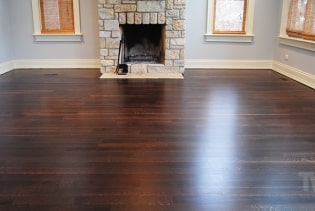
can we apply OSMO on top of Rubio Monocoat.
I am really not happy with the Rubio maintenance and sanding spots even with very low trafficking house in only few months
Hi Nela,
Sorry for the delay in replying, I was on a much needed break.
I’m sorry to hear you’re having trouble. Not sure what you mean by “sanding spots” but it should be easy to maintain. Was it professionally applied? Most times the reason it leaves marks is because there is too much product left on the floor that hasn’t been buffed off properly.
As far as using another hard wax oil over the top, I would not recommend doing it. It’s never good to mix finish systems. Sorry this isn’t the answer you were hoping for.
Tadas
I am debating between using OSMO or pure tung oil – and I would like to stain my floors. My number one priority is ease of maintenance (realizing the “maintenance” on these floors is more than a poly). I have two small children and a big dog, I am more than ok with once a year or so – applying a re-coat and buffing the high traffic areas – in fact the ability to do so is what is attractive about these finishes and why I do not want a poly finish. My concern arises with the desire to stain – if and when I have to spot fix/recoat the floor will the stain be affected and what is the ability to match (this is actually why I do not think I want the Rubio – spot applying a stained wax seems rife with color disasters to me). One guy told me tung oil is actually more difficult to spot repair because it can leave a slightly different color. Any advice would be most appreciated. thank you!
Hi Alyssa,
I would go with OSMO any day over tung oil, much more durable and user friendly for maintenance etc.
Most spot repairs, no matter what the product, are a challenge to repair and match colors with. They take a great deal of skill and patience to do them properly. Hardwax oils are much easier to work with in this regard though compared to polyurethanes and even tung oil. The key will be finding someone that can do a great spot repair/color match so it looks invisible.
Rubio Monocoat is great for simple spot repairs that a homeowner can do (with left over product)and get them close to 90% right because its a one coat finish.
Hope that helps.
Tadas
My husband and I are deciding how to refinish our hardwood floors, which we will do ourselves. (We do not have the budget to hire a contractor.) The floors are oak, about 60 years old and were covered with carpet for some time. (They need to be sanded.)
After reading your blog, we are considering if hard wax oil rather than polyurethane would be a good choice for us. We have a high traffic path through the room and would like to be able to repair the area as needed, rather than refinish the whole room every time the finish wears out.
However, we would like a medium-dark color. If we use a tinted hard wax oil, like Rubio Monocoat, or stain the floor and use Osmo, will we be able to repair the traffic wear later on to match the rest of the room?
Hi Sarah,
Sorry for not getting back to you sooner. Yes that is possible in most situations. There could be slight color or sheen difference depending on the type of wear.
Also, if the wear/damage went through the finish and below the stain then it would complicate the repair immensely.
Hope this helps.
Tadas
I had been considering the Rubio Monocoat on my Southern Yellow Pine. I realize it is not Hardwood but thought I might ask your opinion. Thanks for considering it.
Hi Samuel,
We haven’t personally used this product on Southern Yellow Pine sorry. I would get a sample of the product and do a test on a scrap piece or in a closet to see how it works. I don’t think there would be a problem but we always test first to be sure.
Tadas
Thank you for your thorough articles they have been very useful. I am considering using OSMO oil on recycled 100 year old jarrah floorboards in a new house extension. Similar boards in the old part of the house have unfortunately had a penetrating oil finish and been waxed for decades and require a lot of maintenance, including the hire of a buffing machine on an annual basis. Would the OSMO product give me a similar satin patina to the old waxed boards without buffing? If repairs are made to the OSMO do I need a buffing machine? Do you think I could put OSMO over the old boards if they were sanded? Many thanks for any advice you could give.
Hi Patricia,
You’re welcome, happy to help.
Yes, OSMO has that lovely satin look. If you repair small areas, then no, you won’t need a buffer. You only need it when you need to re-apply a top coat to refresh the entire floor.
As far as applying it over your old boards, yes it is possible. You will need to do a series of compatibility tests in various spots first though before coating the entire floor. The floors will also need to be sanded well and any old wax completely removed. This could be quite the project if they have been waxed annually for 100+ years. But still possible.
Tadas
Hi. Thank you for this great information. I have 1980s beautiful custom oak wood paneled walls that have a finish that is yellowish and flakey on a lot of the trim and some of the wood paneling throughout my house. I have used the Monocoat Pure on a few of the walls and so far it looks great. It has covered many of the nicks and seems to hide the areas where the finish is scratched off. My question to you is… will the finish remain or will it need to be redone? I originally used oil based natural stain to go over it and it looked great for a couple months but then the nicks and scratches started to show again. And it smells horrible for days! I am not certain what the original finish is – maybe varnish or poly??
Thanks!
Hi Sherry,
If you applied it over the existing finish without sanding and removing it unfortunately it will not be a permanent fix. Rubio needs to be applied to clean, unfinished freshly sanded wood.
Hope that helps.
Tadas
Hi,thank you for your helpful blog. We have a unique flooring situation and are looking for the correct finish to the floor. We have an unconditioned cabin in NW MT, which can experience temperatures of 16F to heated temps of 80F. We just installed a fir and larch floor which was mill dried outdoors to hopefully help to compensate for temperature extremes. We want a rustic look so had band saw skip sanding marks done by the mill. We lightly sanded the floor(the saw marks are smoother but not entirely flat/smooth after sanding) and stained with Minwax oil based stain in various shades for a rustic look. In reading all the comments about HWO it sounds like the excess must be thoroughly buffed off to work correctly. I love the idea of an easily repairable/blendable finish vs a poly. I am just not certain with our “rustic” not entirely smooth floor, how this finish would do. We fully recognize that any floor will need maintenance over time and that we may be in uncharted territory with temperature extremes as well as the fact that it is a cabin and is not going to be a “perfect” floor. Nevertheless I’m trying to do the best I can with a finish that is somewhat easy to keep up over the years. Do you have any suggestions for floor finishes for “rustic”, not perfectly smooth floors? Thank you for any helpful tips.
Hi Christine,
Applying a hardwax oil on such a rough floor will be a challenge, but it can be done. It will take a lot longer to apply though and may need to be done partially by hand in areas.
Your other option would be a finish like Loba Invisible Protect AT. It’s a very matte finish like Rubio Monocoat but is a 2 component waterbased finish. Very durable and would look amazing on your rustic floors. It’s easier to spot coat as well due to the zero sheen that is normally an issue to match with most surface finishes.
Tadas
Are you stilll using Osmo Hardwax oil? Have you used Rubio or Woca pure oil finish? Pros and cons on each. Would you be willing to share the names and either email addresses or phone numbers (if they agreed) to see how they liked their Osmo finished floors, especially if they have had them 5-10 years.
I am also confused by your posts. Can a earwax or oil finish be applied if you have already stained the wood. It is my understanding that most of the available wood stains (like Minwax or Duraseal) have both pigments and a sealer. Wouldn’t that prevent penetration of the headway/oil or oil into the wood?
Look forward to your answers.
Hi Tim,
Yes we are. Doing one this week actually. Next month we will be refreshing an OSMO floor from 2002 that we originally did. Still looks great and will look brand new after the refresh.
Yes we use Rubio extensively. There’s many posts on our blog here about Rubio Monocoat. Woca we have used a few times to test it, but don’t offer it. It needs too much maintenance to stay looking good over the years. The other hardwax oils are much better for this.
Yes certain hardwax oils (not earwax lol) can be applied over stain. It actually makes them much more durable. Some like Rubio you can’t do this with. But OSMO and Pallmann Magic Oil you can. There are a few special techniques you need to do in applying them, such as letting the oil soak in longer etc. but it works very well. I just did it on my new floors in my home and we have 3 kids and a new puppy and they’re holding up extremely well.
Hope that helps.
Tadas
Hi, we are building our retirement home, and i love the dark (oak) wood flooring to match antique white cabinets and the antique bronze finishes… but, i have 2 cats who at times scamper around the house leaving some scratches on my current hardwood. What should i tell the builder to use as the BEST topcoat or ? to protect my floors from cats and potential sun damage? Or, just go with a lighter color :-/ floor? Thanks
Hi Jackie,
Dark floors will definitely show scratches more then lighter floors. Glossy finish will show more than matte finishes as well. And two component finishes are tougher than single component ones.
First you should decide what type of finish you want – a hardwax oil finish or a surface finish. This series of articles will help with that:
https://napervillehardwood.com/blog/how-to-choose-hardwood-floor-finish-part-1/
Once you decide on the type of finish and maintenance level you’re after, then you can choose between the best brands. We use Rubio Monocoat and Pallmann Magic Oil for the hardwax oils. For two component surface finishes there are lots of good professional brands like Loba, Pallmann, Bona etc.
We have some great tips about preventing sun damage here that is worth reading:
https://napervillehardwood.com/blog/sunlight-and-fading-hardwood-floors/
Good luck with your retirement home and cats!
Tadas
Hi! I love your blog and appreciate all the great information! I live in Richmond Virginia and we are going to be refinishing our red oak floors. I love the whole idea of hardwax oils, but I don’t love the ultra matte, and al interested in more of a subtle sheen, which is why I’m debating between Pallmann Magic Oil and Osmo Polyx. There are literally only 3 flooring companies who do hardwax. They are mostly experienced with Rubio, Loba and Bona. The guy I’m considering is willing to try another brand and will have a rep come out to advise on the differences, but my question is, for someone experienced with Rubio and Bona, which oil brand would be easier for them, Pallmann or Osmo?
Hi Margaret,
I would suggest Pallmann Magic Oil.
Tadas
I have 28 year old existing red oak flooring in excellent shape, but they have turned pretty red/orange over the last 10 years. I am in the process of installing new white oak quartersawn cabinets in the kitchen and have chosen RMO in natural. I want to continue the red oak through the new kitchen, but I am struggling to find the combination of Rubio products to achieve a medium warm toned brown without the shades of pink/red in the raw oak. And there are no hardwood installers in my area that have experience with RMO to guide me, and am concerned about choosing the pre-aging products as my experimenting with them seems to create a blotchy appearance. Any suggestions?
Hi Anne,
My suggestion would be to use a product from Ciranova called Pinkblocker first. It will remove the red undertones. Then maybe something like Castel Brown or Dark Oak on top would suit the look you’re after.
Tadas
Hi
I am looking to use rubio monocoat on my red oak and I was wondering if you think the Ciranova Pink Blocker really helps to get the “red” out. Your opinion would be greatly appreciated.
Hi Ela,
We’ve been experimenting with Ciranova Pink Blocker and yes, it works quite well.
Tadas